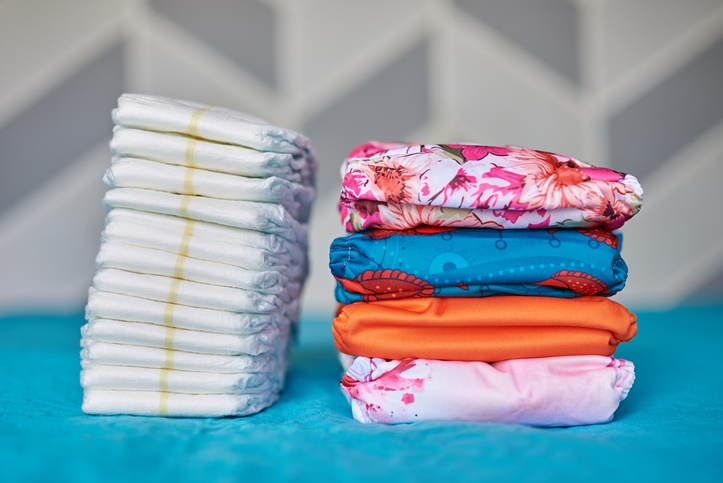
Warnings of imminent climate change, reports of over pollution, a lack of natural resources and many other signs that humans are putting too much strain on the planet are making many parents pause and wonder what the future holds for their children.
There are many ways families can decrease their impact on the earth’s resources, such as reducing waste by re-using or refusing baby items.
One of the most cost-effective and impactful ways a family with little ones can minimise their footprint is by using cloth nappies.
But there is resistance to this route, with many outdated beliefs putting parents off.
Stacey Vermeulen of Biddykins, a South African cloth nappy supplier, tackles some of the stereotypes around cloth nappies.
Also read: What SA parents could expect if we banned disposable nappies
Myth: Newborns go through so many nappies that using cloth nappies is a waste of time and resources.
Because newborns go through so many nappies per day, it actually makes the cloth option more worthwhile, she told us. If you choose flats and covers, which is the most economical newborn option, you can spend between R 1500 - R 2000 for the first 3-4 months.
If you work out the amount of disposables you would use during that time and the cost, you will see that they will be pretty close, but the advantage of cloth is that you can save them for the next baby, and double your saving.
Another popular option is to re-sell them at 50-70% of the price you paid: there’s a huge pre-loved cloth market online!
Also the flats and inserts from newborn nappies make great boosters for the bigger size nappies when you need extra absorption, so they won't go to waste as baby grows.
Must read: How to persuade your daycare to use cloth nappies (or not, as the case may be)
Myth: Cloth nappies use a lot of water and electricity so they’re not that eco-friendly or energy-efficient.
A lot more resources like water, electricity and so on go into the manufacturing of disposable nappies. From personal experience, Stacey shares, "after exclusively using cloth nappies on 2 babies I added 1 to 1.5 extra loads of washing a week."
"I would pre-rinse the nappies in the baby’s leftover bathwater and then add the nappies to the washing of our regular clothes," she says.
Using just 25 nappies for 2 years, and then passing them on to another baby is a huge step towards being eco-friendly, as opposed to throwing away over 5000 disposable nappies by the time a child has potty learned, she explains.
Disposable nappies do not decompose and the harmful chemicals are leached back into our earth.
Also read: Would you support a ban on disposable nappies in South Africa?Myth: They smell and it’s not hygienic to travel with used cloth nappies in your bag.
With the correct wash routine there’s no smell, Stacey says.
"In fact a lot of moms, when switching to a disposable for a holiday, or when smelling them on a friend’s baby, have commented on how the disposables smell so bad," she tells us, adding that there are tips and tricks that you learn along the way during your cloth journey.
These include disposing of the poop into the toilet while out if you can, storing the dirty nappies in a waterproof wet bag until you get home, and using liners to help make clean up easier.
But all the ’nasties’ are sealed in the waterproof bag and then nappies and bag go in the wash at home and come out clean and fresh, she explains. And you don't have poopy nappies in your home or waiting for rubbish removal for days on end.
Myth: Creches and daycares refuse to allow cloth nappies on the premises, supported by government.
No creche can refuse cloth nappies, Stacey reveals.
"What I’ve seen is that a lot don’t know about modern cloth and they are envisioning Terry towels with safety pins and no waterproofing," she says, "but once they are shown how easy they are to put on and take off - the same as a disposable - most are more than happy to give them a try."
There are in fact government rules on using cloth nappies in schools, so they are definitely not against it, she adds.
Myth: There’s no point using cloth nappies on a part-time basis.
Every cloth nappy used is:
1. A cost-saving
2. Saving one less disposable ending up in a landfill
3. Giving your little one’s skin a break from the chemicals in the disposables and a chance to 'breath'
And who knows, if you give it a try, even part-time, you will probably fall in love with them and end up a cloth nappy addict like most of us!
To learn more about cloth nappies read Cloth Nappies 101 or join the South African Cloth Nappy Users Facebook group.
Chatback:
Share your stories and questions with us via email at chatback@parent24.com. Anonymous contributions are welcome.
Don't miss a story!
For a weekly wrap of our latest parenting news and advice sign up to our free Friday Parent24 newsletter.




 Publications
Publications
 Partners
Partners















